A Virtual Tour for the Promotion of Tourism of the City of Bari
Abstract
:1. Introduction
2. Related Work
3. Case Study and Historical Background
Historical Background
- The Cathedral of San Sabino, whose sub-body houses an early medieval basilica and a small Byzantine church;
- The Basilica of San Nicola was built with the arrival of the Saint’s relics in the city;
- The church of San Michele Arcangelo, which housed the relics before the Basilica was built;
- The Norman-Swabian castle, emblematic of the period of militarisation and hierarchisation of the lands at that time.
4. Materials and Methods
4.1. Application Conceptualization
- 1.
- Access and understanding;
- 2.
- Information sources;
- 3.
- Attention to setting and context;
- 4.
- Preservation of authenticity;
- 5.
- Planning for sustainability;
- 6.
- Concern for inclusiveness;
- 7.
- Importance of research, training, and evaluation.
4.2. Application Design
- Move to another point, using arrows, and interact with the objects present; for example, he can obtain information on the monument by means of buttons with a yellow ‘i’ that stands for ’information’;
- Observe the details of some relevant points of the building by means of buttons with a magnifying glass icon, which allow you to zoom in;
- Watch additional videos or photos by means of special buttons.
- Home, which allows you to go back to the previous scene;
- An audio guide button, which activates and deactivates the narrator’s voice present at various points in the scene;
- The music button, which allows you to activate and deactivate the background music;
- The game button, which activates, where present, the game with the historical postcards of the city.
4.3. Content Choice, Creation and Implementation
- 1.
- MenuBari_Scene is the initial scene (Figure 2), in which a 3D model of the city of Bari has been inserted and the user can choose between Bari vecchia and Borgo nuovo. The distinction has been emphasised by associating different colours to the two boroughs and inserting a label above them, made clickable, through which the user is transported to the selected scene. A 360° photo of the city, seen from the sea, was inserted as material in the Skybox as a background for the scene;
- 2.
- BariVecchia_Scene (Figure 3) shows a three-dimensional representation of the old town and its most important monuments that can be visited within the tour (the Basilica of San Nicola, the Norman-Swabian Castle, the Cathedral of San Sabino, the Church of San Michele Arcangelo, Piazza Mercantile and the adjoining Piazza del Ferrarese);
- 3.
- BorgoNuovo_Scene (Figure 4) represents the point where the first stone was laid to create the new town; this scene is characterised by a more pronounced gamification component and makes use of the numerous photos from the years when the Borgo was built, offering a stronger visual impact.
4.4. Implementation and Technological Details
4.5. User Experience Evaluation
5. Data Analysis and Results
Principal Component Analysis
6. Discussion
7. Conclusions
Author Contributions
Funding
Informed Consent Statement
Data Availability Statement
Conflicts of Interest
References
- Olietti, A.; Musso, P. Turismo Digitale: In Viaggio Tra i Click; FrancoAngeli s.r.l.: Milano, Italy, 2018. [Google Scholar]
- UNWTO World Tourism Organization. Turismo e Cultura. Available online: https://www.unwto.org/tourism-and-culture (accessed on 10 July 2022).
- Guttentag, D. Virtual reality: Applications and implications for tourism. Tour. Manag. 2010, 31, 637–651. [Google Scholar] [CrossRef]
- Orlandi, M.; Zambruno, S.; Vazzana, A. Tecnologia, Beni Culturali e Turismo: I Tour Virtuali (Virtual Tours) come strumento per una corretta comunicazione dei Beni Culturali. Storia e Futuro Rivista di Storia e Storiografia Contemporanea Online 2014, 34. Available online: http://storiaefuturo.eu/tecnologia-beni-culturali-e-turismo-tour-virtuali-virtual-tours-come-strumento-per-una-corretta-comunicazione-dei-beni-culturali/ (accessed on 10 July 2022).
- Wu, X.; Lai, I. Identifying the response factors in the formation of a sense of presence and a destination image from a 360-degree virtual tour. J. Destin. Mark. Manag. 2021, 21, 100640. [Google Scholar] [CrossRef]
- Pappa, D.; Makropoulos, C. Novel Ways of Discovering, Capturing and Experiencing Cultural Heritage: A Review of Current State-of-the-Art, Challenges and Future Directions. In Heritage—New Paradigm; Turcanu-Carutiu, P.D., Ed.; IntechOpen: Rijeka, Croatia, 2021; Chapter 36. [Google Scholar] [CrossRef]
- Ren, W.; Chen, X. Evaluation of an Online 360∘ Virtual Reality World Heritage Site during COVID-19. Open Archaeol. 2021, 7, 1192–1215. [Google Scholar] [CrossRef]
- Silberman, N.A. ICOMOS Charter for the Interpretation and Presentation of Cultural Heritage Sites. Int. J. Cult. Prop. 2008, 15, 377–383. [Google Scholar] [CrossRef] [Green Version]
- Bekele, M.; Pierdicca, R.; Frontoni, E.; Malinverni, E.; Gain, J. A survey of augmented, virtual, and mixed reality for cultural heritage. J. Comput. Cult. Herit. 2018, 11, 1–36. [Google Scholar] [CrossRef]
- Shikhri, R.; Lanir, J.; Poretski, L. Evaluation framework for improving 360 virtual tours user experience. In Proceedings of the WebTour@ WSDM, CEUR-WS, Jerusalem, Israel, 12 March 2021; Volume 2855, pp. 16–18. [Google Scholar]
- De Paolis, L.T.; Aloisio, G.; Celentano, M.G.; Oliva, L.; Vecchio, P. A game-based 3D simulation of Otranto in the Middle Ages. In Proceedings of the 3rd International Conference on Advances in Computer-Human Interactions, ACHI 2010, Saint Maarten, Netherlands Antilles, 10–15 February 2010; pp. 130–133. [Google Scholar] [CrossRef]
- De Paolis, L.T.; Aloisio, G.; Celentano, M.G.; Oliva, L.; Vecchio, P. Experiencing a town of the Middle Ages: An application for the edutainment in cultural heritage. In Proceedings of the IEEE 3rd International Conference on Communication Software and Networks, Xi’an, China, 27–29 May 2011; pp. 169–174. [Google Scholar] [CrossRef]
- De Paolis, L.T.; Aloisio, G.; Celentano, M.G.; Oliva, L.; Vecchio, P. MediaEvo project: A serious game for the edutainment. In Proceedings of the 3rd International Conference on Computer Research and Development, Shanghai, China, 11–13 March 2011; Volume 4, pp. 524–529. [Google Scholar] [CrossRef]
- Harun, N.; Yanti Mahadzir, S. 360° Virtual Tour of the Traditional Malay House as an Effort for Cultural Heritage Preservation; IOP Publishing Ltd.: Bristol, UK, 2021; Volume 764. [Google Scholar] [CrossRef]
- De Canio, F.; Martinelli, E.; Peruzzini, M.; Cavallaro, S. Experiencing a Food Production Site Using Wearable Devices: The Indirect Impact of Immersion and Presence in VR Tours. Sustainability 2022, 14, 64. [Google Scholar] [CrossRef]
- Abidin, R.; Suryani, N.; Sariyatun. Students’ Perceptions of 360 Degree Virtual Tour-Based Historical Learning About The Cultural Heritage Area of The Kapitan and Al-Munawar Villages in Palembang City. Int. J. Soc. Sci. Manag. 2020, 7, 105–112. [Google Scholar] [CrossRef]
- El-Said, O.; Aziz, H. Virtual Tours a Means to an End: An Analysis of Virtual Tours’ Role in Tourism Recovery Post COVID-19. J. Travel Res. 2022, 61, 528–548. [Google Scholar] [CrossRef]
- Cirulis, A.; De Paolis, L.; Tutberidze, M. Virtualization of Digitalized Cultural Heritage and Use Case Scenario Modeling for Sustainability Promotion of National Identity; Elsevier B.V.: Amsterdam, The Netherlands, 2015; Volume 77, pp. 199–206. [Google Scholar] [CrossRef]
- Checa, D.; Gatto, C.; Cisternino, D.; De Paolis, L.; Bustillo, A. A Framework for Educational and Training Immersive Virtual Reality Experiences. Lect. Notes Comput. Sci. 2020, 12243, 220–228. [Google Scholar] [CrossRef]
- Hu, Q.; Yu, D.; Wang, S.; Fu, C.; Ai, M.; Wang, W. Hybrid three-dimensional representation based on panoramic images and three-dimensional models for a virtual museum: Data collection, model, and visualization. Inf. Vis. 2017, 16, 126–138. [Google Scholar] [CrossRef]
- Nemtinov, V.; Gorelov, A.; Nemtinova, Y.; Borisenko, A. Virtual immersion into timeframes of residency of the representatives of chicherin family - Famous figures of the russian diplomatic service in the Tambov Region. Bylye Gody 2020, 58, 2305–2314. [Google Scholar] [CrossRef]
- Škola, F.; Rizvić, S.; Cozza, M.; Barbieri, L.; Bruno, F.; Skarlatos, D.; Liarokapis, F. Virtual reality with 360-video storytelling in cultural heritage: Study of presence, engagement, and immersion. Sensors 2020, 20, 5851. [Google Scholar] [CrossRef]
- Iacovino, A.; De Paolis, L.; Ndou, V. Technologies to Support Tourism Innovation and Cultural Heritage: Development of an Immersive Virtual Reality Application. Lect. Notes Comput. Sci. 2020, 12243, 3–14. [Google Scholar] [CrossRef]
- De Paolis, L.T.; Chiarello, S.; D’Errico, G.; Gatto, C.; Nuzzo, B.L.; Sumerano, G. Mobile Extended Reality for the Enhancement of an Underground Oil Mill: A Preliminary Discussion. Lect. Notes Comput. Sci. 2021, 12980, 326–335. [Google Scholar] [CrossRef]
- Cisternino, D.; Gatto, C.; D’Errico, G.; De Luca, V.; Barba, M.; Paladini, G.; De Paolis, L. Virtual Portals for a Smart Fruition of Historical and Archaeological Contexts. Lect. Notes Comput. Sci. 2019, 11614, 264–273. [Google Scholar] [CrossRef]
- Argyriou, L.; Economou, D.; Bouki, V. Design methodology for 360 immersive video applications: The case study of a cultural heritage virtual tour. Pers. Ubiquitous Comput. 2020, 24, 843–859. [Google Scholar] [CrossRef] [Green Version]
- Fabola, A.; Miller, A. Virtual reality for early education: A study. Commun. Comput. Inf. Sci. 2016, 621, 59–72. [Google Scholar] [CrossRef] [Green Version]
- Kang, B.G.; Lee, W.B.; Ryu, S.H. Development of Baekje cultural tourism contents by utilizing portable VR glasses. J. Korea Converg. Soc. 2018, 9, 317–323. [Google Scholar]
- Cisternino, D.; Corchia, L.; De Luca, V.; Gatto, C.; Liaci, S.; Scrivano, L.; Trono, A.; De Paolis, L. Augmented Reality Applications to Support the Promotion of Cultural Heritage. J. Comput. Cult. Herit. 2021, 14, 1–30. [Google Scholar] [CrossRef]
- Conoscendo. Gli JAPIGI. Available online: http://conoscendo.altervista.org/gli-japigi/ (accessed on 10 July 2022).
- Petrignani, M.; Porsia, F. Le Città nella Storia d’Italia—Bari; Editori Laterza: Bari, Italy, 1988. [Google Scholar]
- Melchiorre, V. Bari nella Storia; Adda: Bari, Italy, 2002. [Google Scholar]
- Depalo, M.R.; Disantarosa, G.; Nuzzo, D. CITTADELLA NICOLAIANA—1 Archeologia urbana a Bari nell’Area della Basilica di San Nicola; Editori Laterza: Bari, Italy, 2015. [Google Scholar]
- Fondazione Petruzzelli. La Storia del Teatro Petruzzelli. Available online: https://www.fondazionepetruzzelli.it/il-teatro/ (accessed on 10 July 2022).
- Colaninno, A. Il Liberty a Bari. Available online: http://www.italialiberty.it/liberty-bari/ (accessed on 10 July 2022).
- Lattanzio, F. Il Quartiere Umbertino: Fra Teatri e Palazzi Liberty, lì Dove Bari si Fa Elegante. 2016. Available online: https://www.barinedita.it/storie-e-curiosita/n2305-il—quartiere-umbertino—-fra-teatri-e-palazzi-liberty-li-dove-bari-si-fa-elegante (accessed on 10 July 2022).
- Quickstart for Google Cardboard for Unity. 2022. Available online: https://developers.google.com/cardboard/develop/unity/quickstart (accessed on 10 July 2022).
- International Organization For Standardization (ISO). ISO/IEC 25010:2011; Systems and Software Engineering—Systems and Software Quality Requirements and Evaluation (SQuaRE)—System and Software Quality Models; ISO: Geneva, Switzerland, 2011. [Google Scholar]
- Lewis, J.; Utesch, B.; Maher, D. UMUX-LITE—When there’s no time for the SUS. In Proceedings of the SIGCHI Conference on Human Factors in Computing Systems, Paris, France, 27 April–2 May 2013; pp. 2099–2102. [Google Scholar] [CrossRef]
- Brooke, J. SUS—A quick and dirty usability scale. Usability Eval. Ind. 1996, 189, 4–7. [Google Scholar]
- Lewis, J.R.; Sauro, J. The factor structure of the system usability scale. In Human Centered Design, Lecture Notes in Computer Science; Kurosu, M., Ed.; Springer: Berlin/Heidelberg, Germany, 2009; pp. 94–103. [Google Scholar] [CrossRef]
- Kline, P. An Easy Guide to Factor Analysis; Routledge: London, UK, 2002. [Google Scholar]
- Kaiser, H. The varimax criterion for analytic rotation in factor analysis. Psychometrika 1958, 23, 187–200. [Google Scholar] [CrossRef]
- Hendrickson, A.; White, P. PROMAX: A quick method for rotation to oblique simple structure. Br. J. Stat. Psychol. 1964, 17, 65–70. [Google Scholar] [CrossRef]
- Slater, M.; Usoh, M.; Steed, A. Depth of Presence in Virtual Environments. Presence Teleoperators Virtual Environ. 1994, 3, 130–144. [Google Scholar] [CrossRef]
- Slater, M.; Wilbur, S. A framework for immersive virtual environments (FIVE): Speculations on the role of presence in virtual environments. Presence Teleoperators Virtual Environ. 1997, 6, 603–616. [Google Scholar] [CrossRef]
- Khalifa, M.; Shen, N. System Design Effects on Social Presence and Telepresence in Virtual Communities. In Proceedings of the 25th International Conference on Information Systems ICIS’04, Washington, DC, USA, 12–15 December 2004; pp. 547–558. [Google Scholar]
- O’Brien, H.; Cairns, P.; Hall, M. A practical approach to measuring user engagement with the refined user engagement scale (UES) and new UES short form. Int. J. Hum. Comput. Stud. 2018, 112, 28–39. [Google Scholar] [CrossRef]
- Brodie, R.; Ilic, A.; Juric, B.; Hollebeek, L. Consumer engagement in a virtual brand community: An exploratory analysis. J. Bus. Res. 2013, 66, 105–114. [Google Scholar] [CrossRef]
- Witmer, B.G.; Singer, M.J. Measuring presence in virtual environments: A presence questionnaire. Presence Teleoperators Virtual Environ. 1998, 7, 225–240. [Google Scholar] [CrossRef]
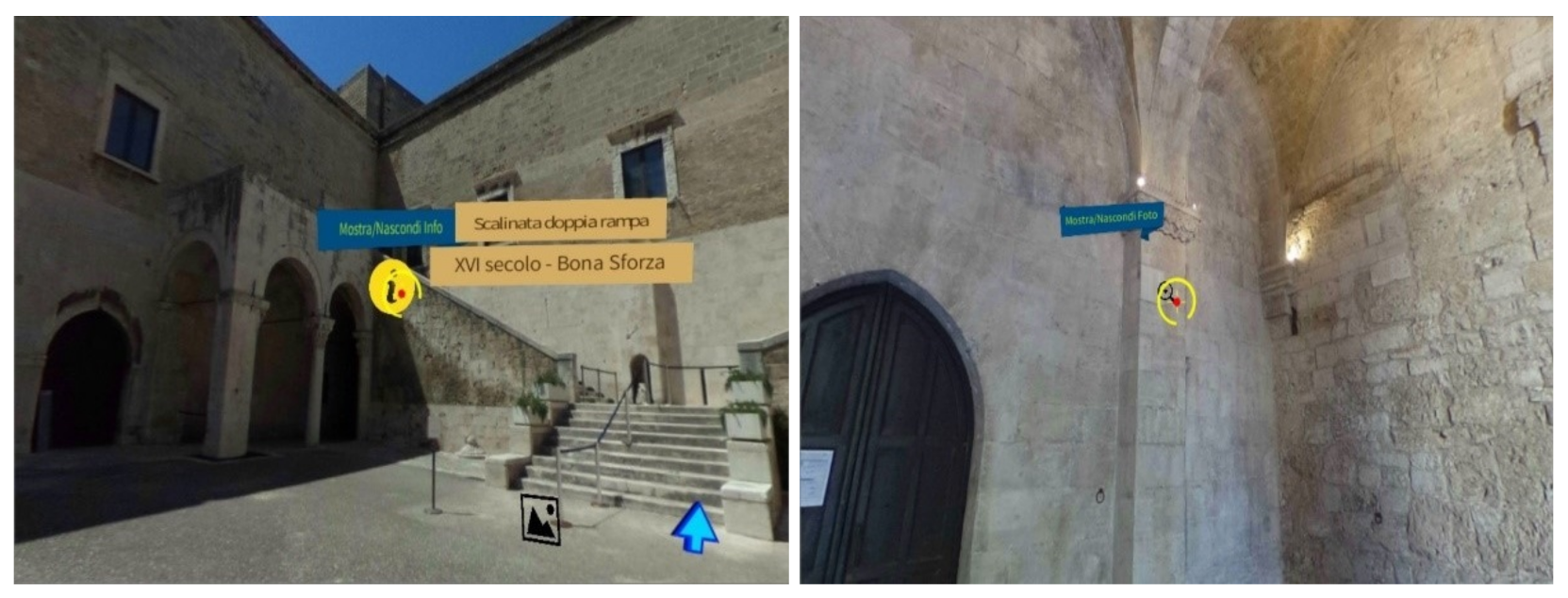


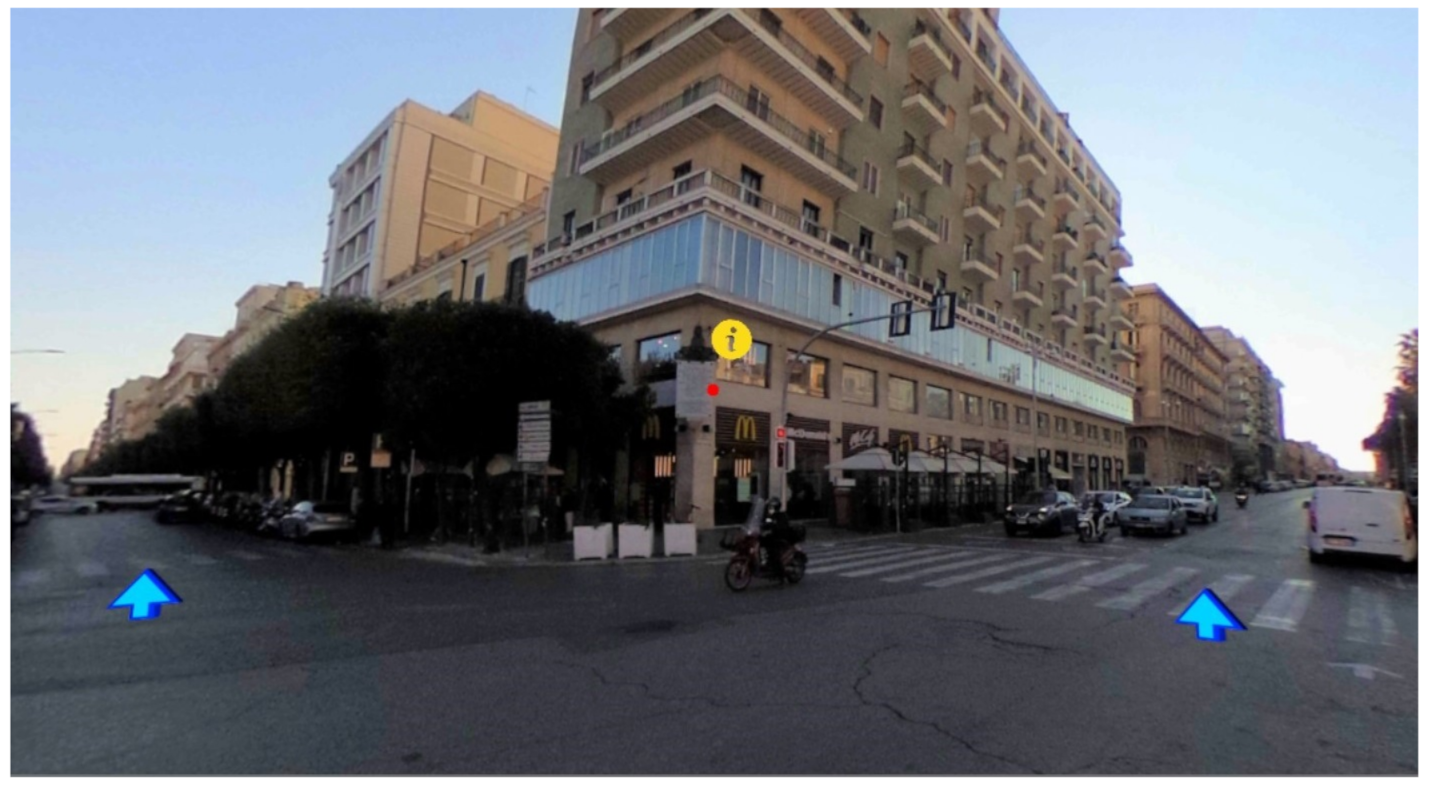
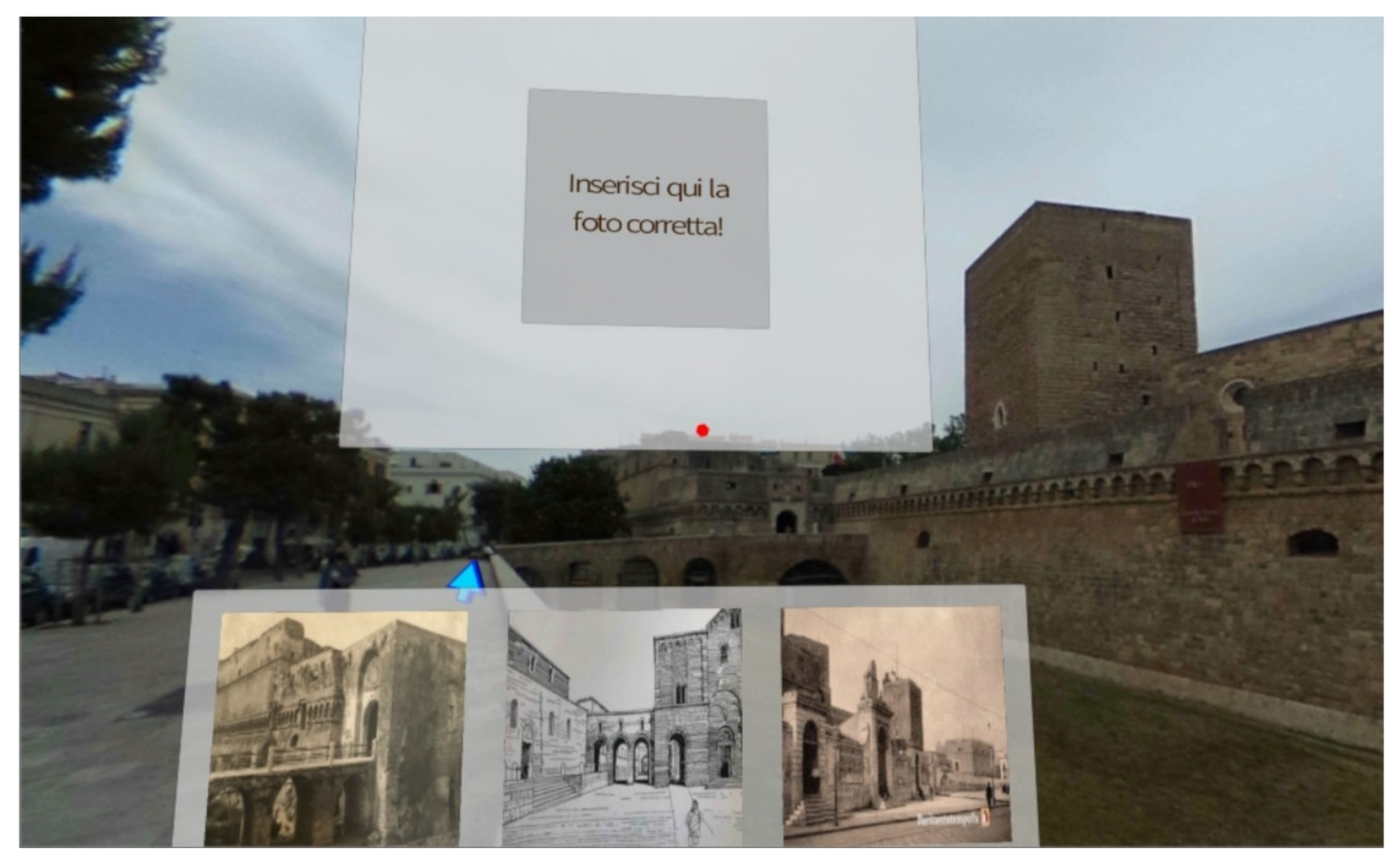
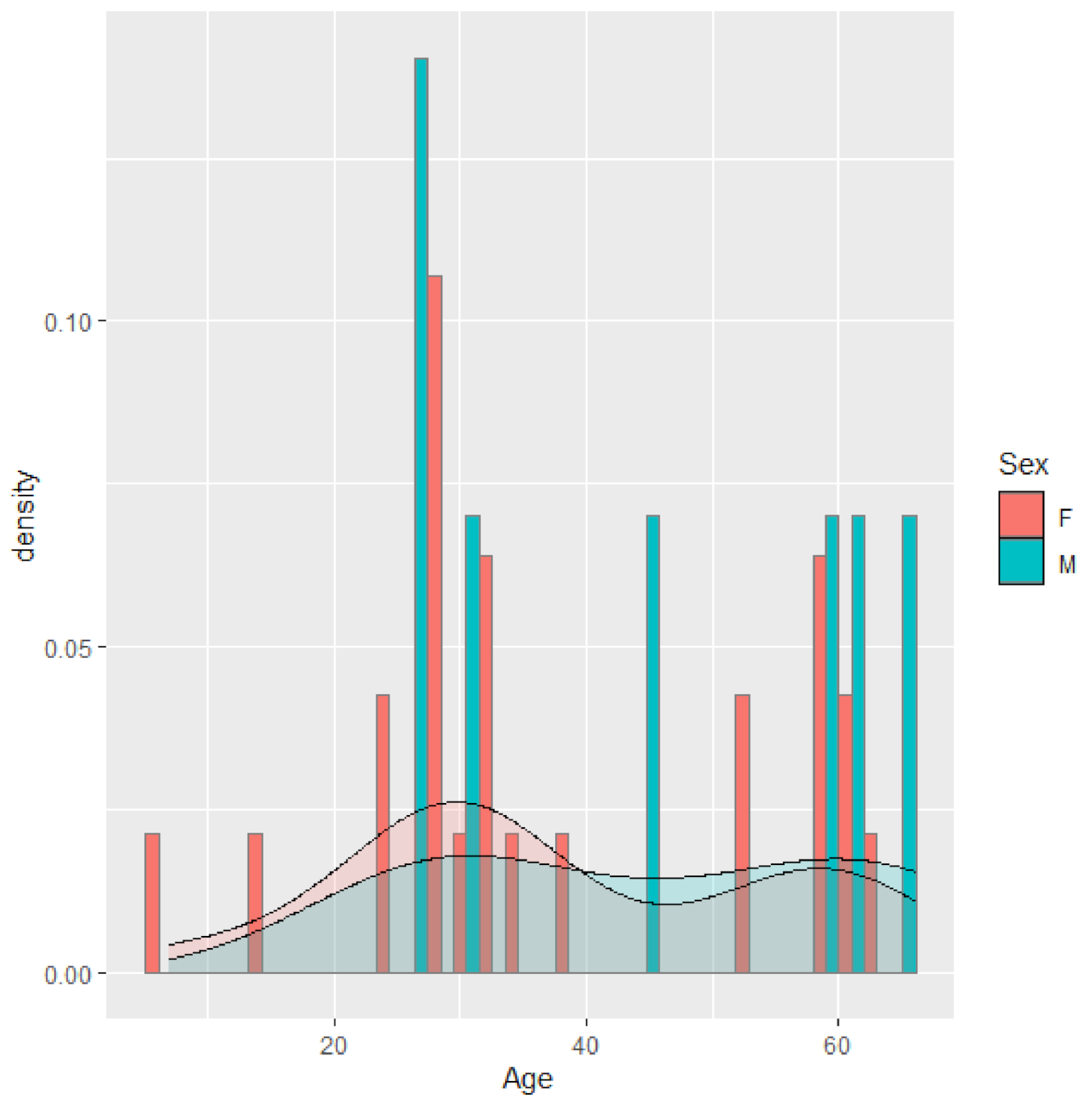
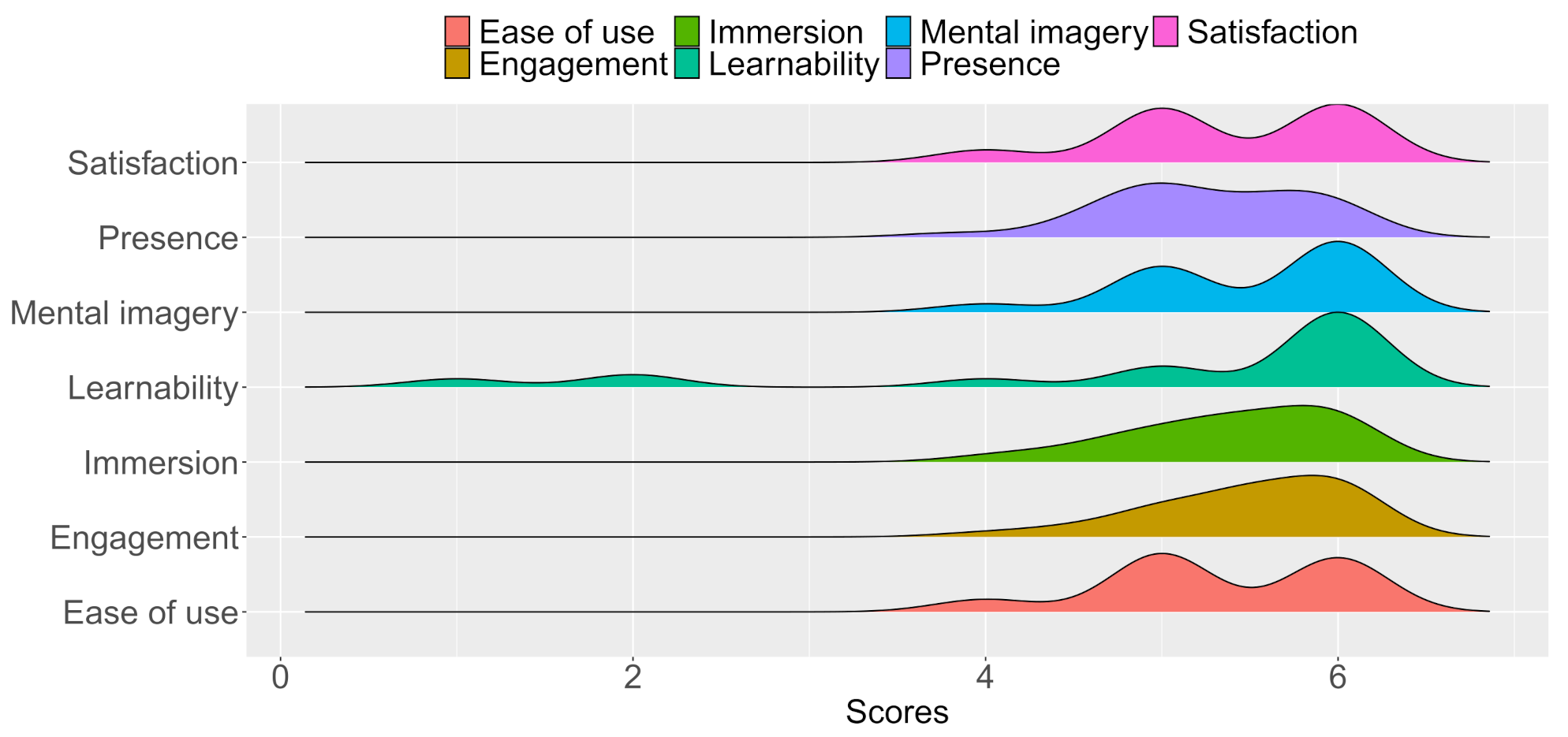
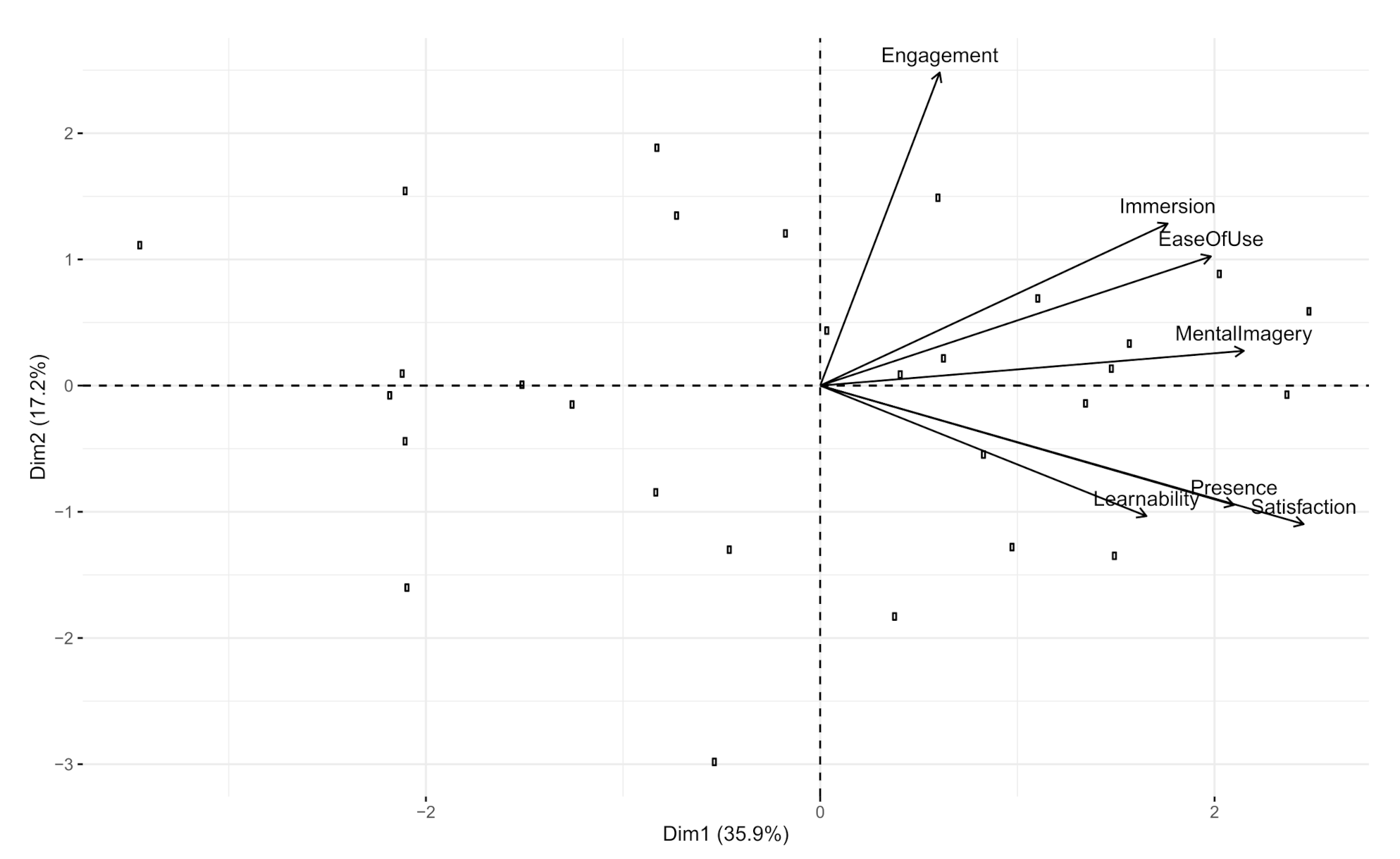
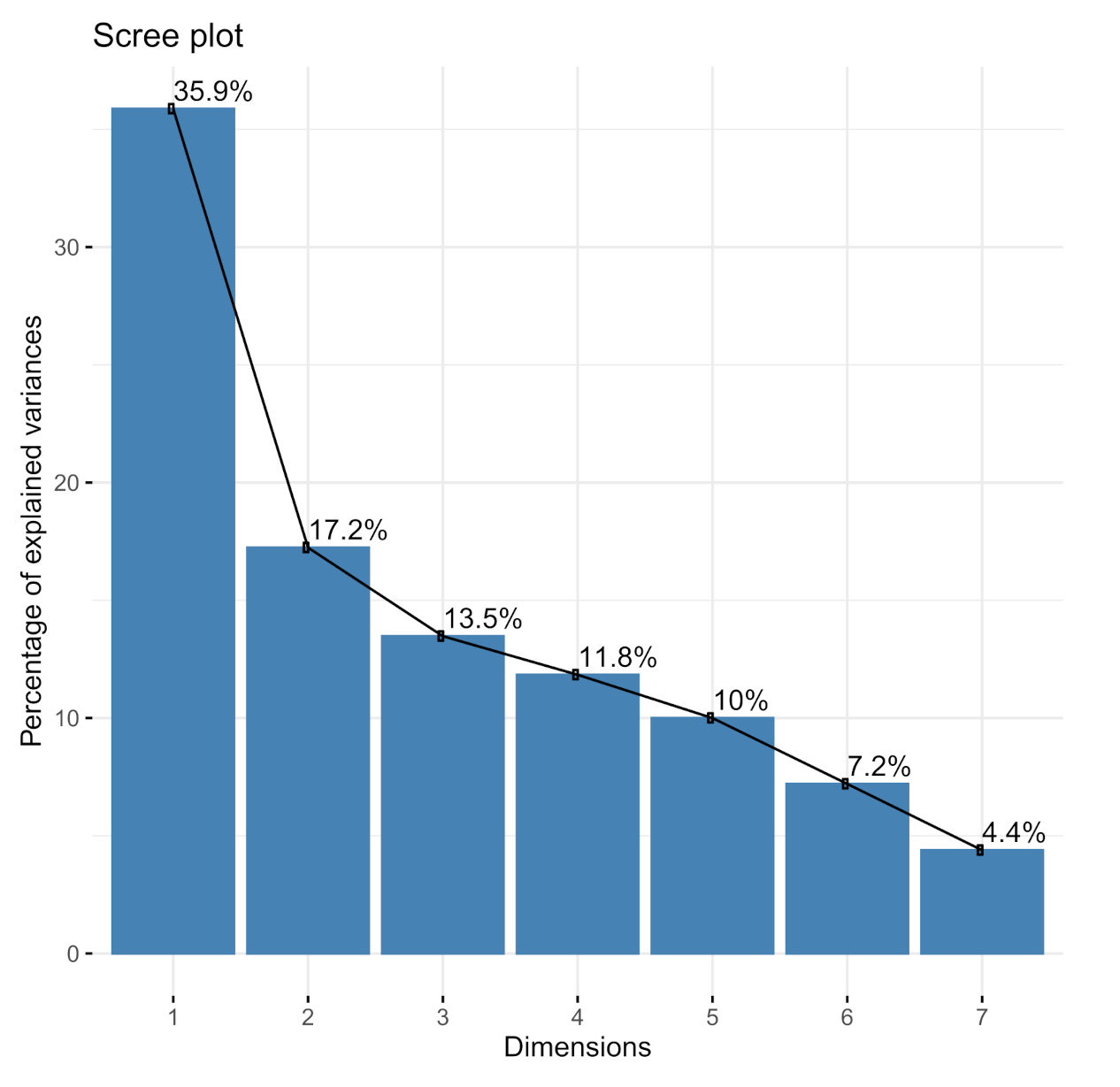

| Factor | Item |
|---|---|
| Engagement (VR360 [5]) | I felt deeply involved in the virtual tour |
| I focused completely on the virtual tour | |
| Immersion (VR360 [5]) | I could interact with the tour view as if I were in the real world |
| I felt detached from the outside world | |
| I felt completely immersed | |
| I forgot my worries during the virtual tour | |
| Mental imagery (VR360 [5]) | The images of the scenes have a good visual impact |
| Presence (VR360 [5]) | After the virtual tour I felt as if I had returned to the real world after a journey |
| The world generated by the virtual tour felt like a place I visited rather than something I saw | |
| During the virtual tour I felt like I was really in Bari | |
| During the virtual tour I sometimes forgot that I was in the middle of a virtual experience | |
| My body was in a place, but my mind was inside the world created by the tour | |
| Satisfaction (UMUX-lite [39]) | The system capabilities meet my requirements |
| Ease of use (UMUX-lite [39]) | The system is easy to use |
| Learnability (item 10 from SUS [40]) | I needed to learn a lot of things before I could get going with this system |
| User Experience Factor | Mean | Standard Deviation | Coefficient of Variation |
|---|---|---|---|
| Engagement | 5.483 | 0.540 | 0.098 |
| Immersion | 5.392 | 0.565 | 0.105 |
| Mental imagery | 5.500 | 0.619 | 0.113 |
| Presence | 5.260 | 0.552 | 0.105 |
| Satisfaction | 5.367 | 0.657 | 0.123 |
| Ease of use | 5.333 | 0.650 | 0.122 |
| Learnability | 4.967 | 1.622 | 0.327 |
| Principal Component | Standard Deviation | Proportion of Variance | Cumulative Proportion |
|---|---|---|---|
| PC1 | 1.5845917 | 0.3587044 | 0.3587044 |
| PC2 | 1.0984372 | 0.1723663 | 0.5310707 |
| PC3 | 0.9712090 | 0.1347496 | 0.6658203 |
| PC4 | 0.9101914 | 0.1183498 | 0.7841701 |
| PC5 | 0.83651936 | 0.09996638 | 0.88413644 |
| PC6 | 0.70994857 | 0.07200385 | 0.95614030 |
| PC7 | 0.5540920 | 0.0438597 | 1.0000000 |
| User Experience Factor | PC1 | PC2 | PC3 | PC4 |
|---|---|---|---|---|
| Engagement | −0.193 | 0.823 | ||
| −0.105 | 0.850 | −0.108 | ||
| Immersion | −0.176 | −0.795 | 0.114 | |
| −0.172 | 0.123 | −0.835 | 0.106 | |
| Mental imagery | 0.230 | −0.572 | −0.110 | |
| 0.205 | −0.533 | |||
| Presence | 0.535 | −0.163 | −0.168 | |
| 0.516 | −0.231 | |||
| Satisfaction | 0.624 | 0.108 | 0.227 | |
| 0.670 | 0.159 | 0.281 | ||
| Ease of use | 0.444 | 0.532 | −0.225 | |
| 0.477 | 0.460 | −0.196 | ||
| Learnability | 0.926 | |||
| 0.183 | 0.952 |
Publisher’s Note: MDPI stays neutral with regard to jurisdictional claims in published maps and institutional affiliations. |
© 2022 by the authors. Licensee MDPI, Basel, Switzerland. This article is an open access article distributed under the terms and conditions of the Creative Commons Attribution (CC BY) license (https://creativecommons.org/licenses/by/4.0/).
Share and Cite
De Luca, V.; Marcantonio, G.; Barba, M.C.; De Paolis, L.T. A Virtual Tour for the Promotion of Tourism of the City of Bari. Information 2022, 13, 339. https://doi.org/10.3390/info13070339
De Luca V, Marcantonio G, Barba MC, De Paolis LT. A Virtual Tour for the Promotion of Tourism of the City of Bari. Information. 2022; 13(7):339. https://doi.org/10.3390/info13070339
Chicago/Turabian StyleDe Luca, Valerio, Giorgia Marcantonio, Maria Cristina Barba, and Lucio Tommaso De Paolis. 2022. "A Virtual Tour for the Promotion of Tourism of the City of Bari" Information 13, no. 7: 339. https://doi.org/10.3390/info13070339
APA StyleDe Luca, V., Marcantonio, G., Barba, M. C., & De Paolis, L. T. (2022). A Virtual Tour for the Promotion of Tourism of the City of Bari. Information, 13(7), 339. https://doi.org/10.3390/info13070339







